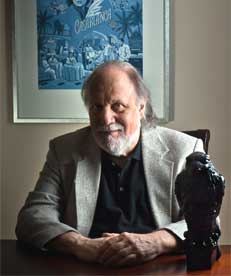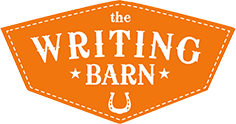 Today, a few weeks before his Sept. 21st morning class here at The Writing Barn,we invite you to get to know The Art of Storytelling instructor, veteran Hollywood screenwriter, Michael B. Druxman a bit better. Thank you to Michael, for taking the time out of his schedule to have a sit-down chit chat with us.
Today, a few weeks before his Sept. 21st morning class here at The Writing Barn,we invite you to get to know The Art of Storytelling instructor, veteran Hollywood screenwriter, Michael B. Druxman a bit better. Thank you to Michael, for taking the time out of his schedule to have a sit-down chit chat with us.
WRITING BARN: Welcome, Michael. As a screenwriter and a novelist, what are the similarities and differences of the various forms?
MICHAEL DRUXMAN: Certainly the biggest difference between writing a novel and a screenplay is “real estate”.
With a novel, you have 200-400 pages or more to tell your story and develop your characters. Your normal screenplay is about 120 pages in length, so that you have to boil your story down to its essence and paint your characters in broader strokes. But, you also need to include enough detail (or hints) about the characters so that the actors can flesh them out through their performances.
Film is a collaborative medium and depends more on visual images than the spoken or written word. A good actor can often convey a writer’s intent with a look rather than a line of dialogue.
Additionally, unless there is something special about a location, all a screenwriter has to write is that a scene is set in, say a restaurant. You can even indicate what kind of restaurant if you feel it is important to the scene. Beyond that, the director and art director take over.
When you’re writing a novel, however, that setting might have to be more carefully described, so that the reader can visualize it.
The same applies to characters. When you are working on a novel, you have much more freedom to expand on a character’s physical characteristics and background.
That’s not to say that, with a screenplay, you shouldn’t know your character’s background or physical characteristics. But, in that medium, they become subtext.
WB: You are a veteran Hollywood screenwriter, what is your favorite behind-the-scenes tale of that time in your life?
MD: This not my favorite story, but does give one a pretty good idea as to how Hollywood producers think. Roger Corman wanted me to do some work on King Dinosaur, a script that would, ultimately, be released as Raptor.
In 1993, anticipating the release of Jurassic Park, Roger had made his own dinosaur movie,Carnosaur. Naturally, it was a low budget effort, but it had done so well in home video sales that he’d produced sequels to that opus in 1995 and 1996.
Being the “recycler” that he is, Roger came up with the idea of taking the dinosaur footage from those three Carnosaur films and incorporating it into a brand new movie. Frances Doel, his story editor, had written the first draft of the script, and now they wanted me to do a “character and dialogue” polish.
I read the script, looked at the footage and then I gave Frances my honest assessment. “I can make this better,” I said, “but there is no way that I can make this ‘good’.”
“Better is good,” Frances said, and I went to work.
Often in Hollywood, a job is just a job.
WB: In your Writing Barn class, The Art of Storytelling, on Saturday September 21st, you plan to discuss 3 Act Structure and how it differs from plotting, what other tips and treats, are attendees in for?

MD: I will be discussing character development, dialogue, conflict and several other topic, including one that writers often have problems with: How to effectively deal with exposition.
WB: Who will benefit most from taking your Art of Storytelling class? And why?
MD: New writers will learn the bare essentials of storytelling, while more experienced writers, dealing with a “block” on a particular story, will get some useful tools on how to surmount that block.
WB: Thanks for being with us, Michael. A novelist, screenwriter, or a newcomer to either form, don’t miss The Art of Storytelling. For more information and to register, go here.
Michael B. Druxman is a veteran Hollywood screenwriter whose credits include Cheyenne Warrior with Kelly Preston; Dillinger and Capone starring Martin Sheen and F. Murray Abraham; and The Doorway with Roy Scheider, which he also directed. Additionally, Mr. Druxman is the author of more than fifteen published books, including several nonfiction works about Hollywood, its movies, and the people who make them (e.g., Basil Rathbone: His Life and His Films, Make It Again, Sam: A Survey of Movie Remakes, One Good Film Deserves Another: A Survey of Movie Sequels, Merv [Griffin]and The Musical: From Broadway to Hollywood).
He has taught various dramatic writing and film appreciation courses in an adult university and is the author of How to Write a Story…Any Story: The Art of Storytelling, which has been used as a text in several colleges. He is often invited to speak to groups of aspiring film and television professionals to discuss screenwriting and the realities of show business. A native of Seattle who graduated from Garfield High School and the University of Washington, Mr. Druxman moved with his wife, Sandy, from Los Angeles to Austin, TX in 2009. His memoir, My Forty-Five Years in Hollywood and How I Escaped Alive, is published by Bear Manor Media. To learn more, visit his website at http://www.druxmanworks.com.
